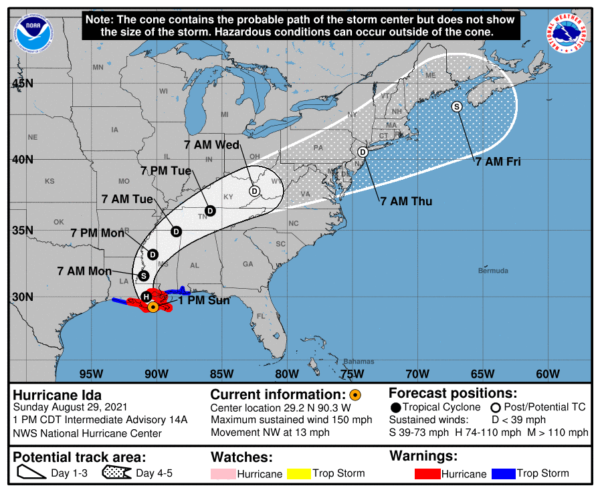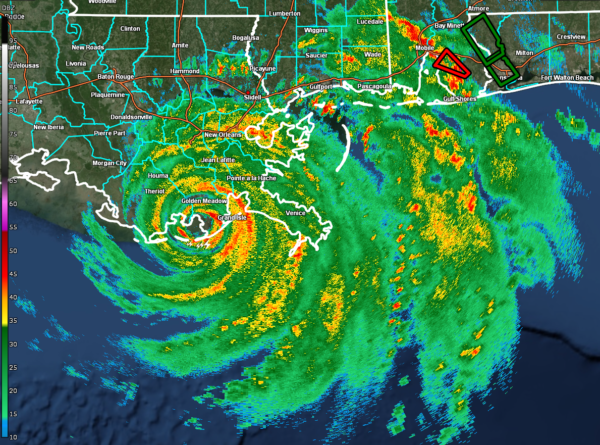1 pm Advisory — Eye of Hurricane Ida Continues to Move Inland
SUMMARY OF 1 PM CDT INFORMATION
LOCATION…29.2N 90.3W
ABOUT 20 MI…30 KM W OF GRAND ISLE, LOUISIANA
ABOUT 55 MI…90 KM SSW OF NEW ORLEANS, LOUISIANA
MAXIMUM SUSTAINED WINDS…150 MPH…240 KM/H
PRESENT MOVEMENT…NW OR 320 DEGREES AT 13 MPH…20 KM/H
MINIMUM CENTRAL PRESSURE…930 MB…27.46 INCHES
WATCHES AND WARNINGS
A Storm Surge Warning is in effect for…
* Intracoastal City, Louisiana, to the Alabama/Florida border
* Vermilion Bay, Lake Borgne, Lake Pontchartrain, Lake Maurepas, and Mobile Bay
A Hurricane Warning is in effect for…
* Intracoastal City, Louisiana, to the Mouth of the Pearl River
* Lake Pontchartrain, Lake Maurepas, and Metropolitan New Orleans
A Tropical Storm Warning is in effect for…
* Cameron Louisiana to west of Intracoastal City, Louisiana
* Mouth of the Pearl River to the Alabama/Florida border
FORECAST DISCUSSION
At 100 PM CDT (1800 UTC), the eye of Hurricane Ida was located by NWS Doppler radar near latitude 29.2 North, longitude 90.3 West. Ida is moving toward the northwest near 13 mph (20 km/h), and a slightly slower northwestward motion should continue through this evening. A turn toward the north should occur by Monday morning, followed by a slightly faster northeastward motion by Monday night and Tuesday. On the forecast track, the center of Ida will move farther inland over southeastern Louisiana this afternoon and tonight. Ida is then forecast to move well inland over portions of Louisiana and western Mississippi Monday and Monday night, and move across the Tennessee Valley on Tuesday.
Maximum sustained winds are near 150 mph (240 km/h) with higher gusts. Ida is an extremely dangerous category 4 hurricane on the Saffir-Simpson Hurricane Wind Scale. Rapid weakening is expected during the next day or so, however Ida is forecast to remain a hurricane through late tonight.
Hurricane-force winds extend outward up to 50 miles (85 km) from the center, and tropical-storm-force winds extend outward up to 150 miles (240 km). A Florida Coastal Monitoring Observation Tower at South Lafourche Airport recently reported a sustained wind of 70 mph (113 km/h) and a wind gust of 102 mph (164 km/h). A sustained wind of 47 mph (60 km/h) and a gust of 63 mph (102 km/h) were recently reported at Lakefront Airport in New Orleans.
A NOAA National Ocean Service tide gauge in Shell Beach, Louisiana, recently reported a water level of 6.8 feet above mean higher high water, which is an approximation of inundation in that area.
The estimated minimum central pressure is 930 mb (27.46 inches).
HAZARDS TO LAND
STORM SURGE: The combination of a dangerous storm surge and the tide will cause normally dry areas near the coast to be flooded by rising waters moving inland from the shoreline. The water could reach the following heights above ground somewhere in the indicated areas if the peak surge occurs at the time of high tide…
• Port Fourchon, LA to Mouth of the Mississippi River…12-16 ft
• Morgan City, LA to Port Fourchon, LA…8-12 ft
• Mouth of the Mississippi River to Bay St. Louis, MS including Lake Borgne…8-12 ft
• Bay St. Louis, MS to Ocean Springs, MS…5-8 ft
• Burns Point, LA to Morgan City, LA…5-8 ft
• Lake Pontchartrain…5-8 ft
• Ocean Springs, MS to MS/AL border…4-7 ft
• Lake Maurepas…4-6 ft
• East of Intracoastal City, LA to Burns Point, LA including Vermilion Bay…3-5 ft
• MS/AL border to AL/FL border including Mobile Bay…3-5 ft
• Rockefeller Wildlife Refuge, LA to Intracoastal City, LA…1-3 ft
• AL/FL border to Okaloosa/Walton County Line, including Pensacola Bay…1-3 ft
Overtopping of local levees outside of the Hurricane and Storm Damage Risk Reduction System is possible where local inundation values may be higher than those shown above.
The deepest water will occur along the immediate coast near and to the east of the landfall location, where the surge will be accompanied by large and dangerous waves. Surge-related flooding
depends on the relative timing of the surge and the tidal cycle, and can vary greatly over short distances.
WIND: Catastrophic wind damage is likely near the core of Ida as it moves inland over southeastern Louisiana through this afternoon.
Hurricane conditions will spread farther inland within the Hurricane Warning area over southeastern Louisiana through tonight. Tropical storm conditions will also spread inland over portions of Louisiana and Mississippi tonight and Monday.
RAINFALL: Heavy rainfall from Ida will continue to impact the southeast Louisiana coast this morning, spreading northeast into the Lower Mississippi Valley later today into Monday. Total rainfall accumulations of 10 to 18 inches, with isolated maximum amounts of 24 inches, are possible across southeast Louisiana into far southern Mississippi through Monday. This is likely to result in life-threatening flash and urban flooding and significant riverine flooding impacts.
Ida is forecast to turn to the northeast early Monday and track across the Middle Tennessee Valley and Upper Ohio Valley through Wednesday, producing the following rainfall totals:
Coastal Alabama to the far western Florida panhandle: 5 to 10 inches, with isolated maximum amounts of 15 inches, today through Tuesday morning.
Central Mississippi: 4 to 8 inches, with isolated maximum amounts of 12 inches, tonight through Monday night.
Middle Tennessee Valley, Upper Ohio Valley, Central Appalachians into the Mid-Atlantic: 3 to 6 inches with isolated higher amounts, Tuesday into Wednesday.
These rainfall totals will result in considerable flash and riverine flooding.
TORNADOES: Tornadoes will be most likely through Monday over southeast Louisiana, southern Mississippi, southwest Alabama, and the western Florida Panhandle. A few tornadoes are also possible farther north across much of Mississippi and Alabama on Monday.
SURF: Swells will affect the northern Gulf coast through early Monday. These swells are likely to cause life-threatening surf and rip current conditions.
All images, forecasts, and documents are courtesy of their respective publishers.
Category: Alabama's Weather, ALL POSTS, Severe Weather, Tropical

















